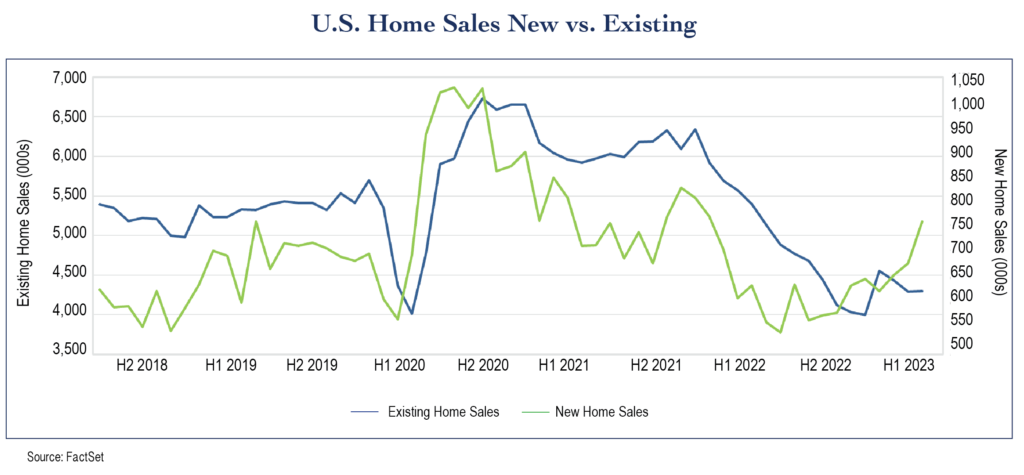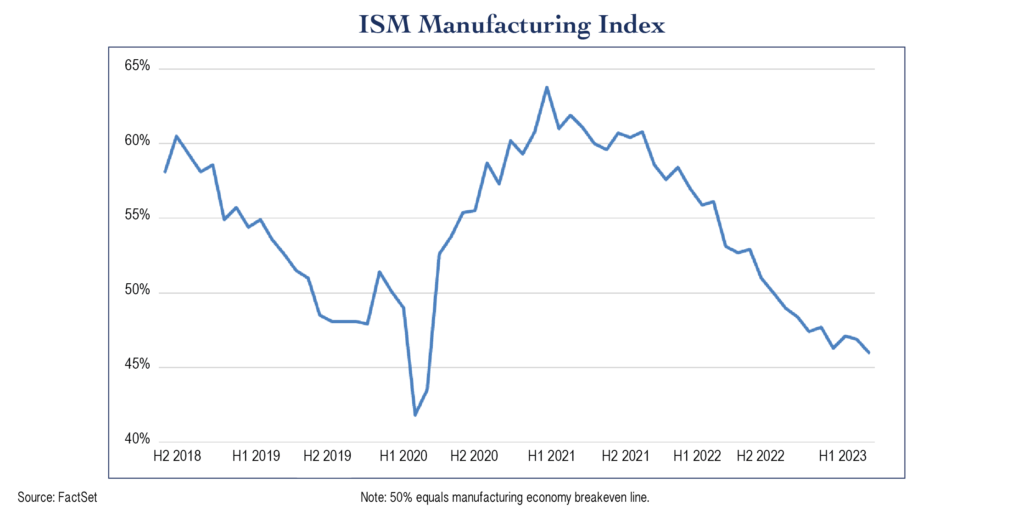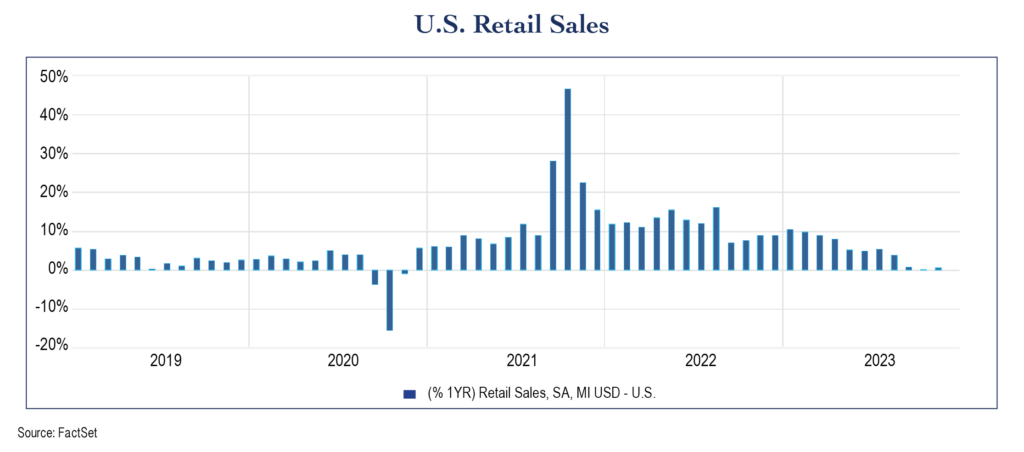The Second Quarter of 2023: Stop, Look and Listen
By: Eric Schopf
After ten consecutive interest rates increases, the Federal Reserve paused in June to survey the damage. Although there have been some big bumps along the way, the economic landscape appears relatively healthy. Recessionary fears have abated and the stock market is reflecting revised expectations. The Standard and Poor’s 500 Index provided a total return of 8.74% in the quarter, elevating the year-to-date return to 16.89%. The placid landscape has left bond investors more skeptical, with quarterly returns once again sliding into the red. The Bloomberg US Aggregate Bond Index lost 0.84% during the quarter, bringing the year-to-date return down to a positive 2.09%.
Strong stock market returns help gloss over the bumps caused by higher interest rates. The first casualty was the housing market. Home sales, both new and existing, plunged from mid-2020 through the third quarter of 2022. Existing home sales have recovered slightly, but the golden handcuffs of a locked-in fixed rate long-term mortgage have many homeowners reluctant to move, and the lack of supply has prevented a meaningful recovery. New home sales, on the other hand, have experienced a strong rebound. Homebuilders can offer financial incentives to help reduce the burden of higher mortgage rates. With a temporary rate buydown, the builder pays some of the buyer’s interest for a defined period. The builder’s payment of discount points can reduce the interest rate for the entire term of the mortgage.
The failures of Silicon Valley Bank, Signature Bank and First Republic Bank earlier this year have also faded into memory. What cannot be forgotten is that, combined, the three banks held assets of nearly $550 billion. These three failures alone almost reached the $676 billion level of assets held by the 414 banks that failed during the financial crisis of 2008 through 2011. A pause by the Fed is warranted given the rapid increase in interest rates that commenced just fifteen months ago. Typically, as interest rates are driven higher by the Federal Reserve, cracks begin to form. Warren Buffet famously once said that “Only when the tide goes out do you learn who has been swimming naked.” Although some cracks have become apparent, the much-anticipated recession has not materialized.
A pause gives the Fed time to continue monitoring data on inflation, employment and economic growth. While the data continues to be mixed, progress has been made. Inflation is moderating, but at a slower pace than expected. Initial claims for unemployment are trending higher, but job growth more than exceeds new entrants to the workforce, and tight labor conditions have supported strong wage growth. Gross domestic product, a gauge for economic growth, was 2% in the first quarter. The trend has been for slower growth over the last two quarters, but it is on par with pre-pandemic levels. The Fed began its journey with the federal funds rate at 0.25% in March 2022. With the rate now at 5.25%, the pause makes sense if for no other than reason to give the higher rate a chance to breathe. Milton Friedman, a Nobel Prize winning economist, coined the phrase “long and variable lags” in 1961 when commenting about the impact of Federal Reserve interest rate hikes. A pause provides the current set of Federal Reserve governors time to let higher rates percolate throughout the economy.
Other, more granular, economic data indicates that the Fed is winning its battle to slow the economy in order to reduce inflationary pressure. The ISM manufacturing index, which gathers data from purchasing managers on new orders, production, employment and inventories, has been flashing a slow-down since November. The money supply has been contracting steadily following the pandemic-driven explosion. Fewer dollars chasing more goods and services is a disinflationary force. Retail spending has slowed considerably following two years of pandemic-driven consumption. Finally, Senior Loan Officer Survey data reveals that banks have materially tightened commercial and industrial real estate loan underwriting standards. Money is harder to come by and more expensive.
Although the S&P 500 has delivered a strong result so far this year, the beauty has only been skin deep. Just seven companies have been responsible for most of the return. Meta (Facebook), Apple, Amazon, Netflix, Alphabet (Google), Microsoft, Nvidia and Tesla combined represent almost 80% of the total return, or 13.5%. The remaining 493 companies contributed only about 3.5%. The skin, however, is thick. The Standard & Poor’s Index is capitalization-weighted. Companies with the largest capitalization (shares outstanding multiplied by price per share) are given the most weight when calculating index returns. These seven stocks represent about 26% of the S&P 500 Index. An equally-weighted index of S&P 500 stocks provided a more pedestrian return of 6.93%. The Dow Jones Industrial Average, by comparison, is a price-weighted index. The index return of the thirty constituents is weighted based on stock prices. The largest three components of the Dow are UnitedHealth Group, Microsoft and McDonalds. The difference in constituents and weightings makes a big difference, as the Dow has returned just 4.94% through June 30. The broader weakness is visible in many other equity indexes. The Russell Top 200 Value Index, which includes the 200 largest U.S. value companies based on price-to-book ratios and growth forecasts, has returned just 4.8% this year. The S&P 500 Dividend Aristocrats Index, comprised of 66 companies that have increased their dividends every year for at least twenty-five years, has delivered a total return of 5.72%. Diversification has not been rewarded. Lower broad-market returns reflect falling corporate profits and economic concerns, and profits peaked last June and have yet to eclipse those record levels. Anticipated future profitability linked to the development of Artificial Intelligence (AI) applications is behind much of the appreciation in the seven companies responsible for the S&P performance.
Should June represent a skip in the interest rate trajectory instead of a pause, we will face the same risk – the Fed goes too far, leading to a recession. Alone, monetary policy is not as feared now as earlier in the cycle given the recent disinflationary data. However, remnants of pandemic era fiscal policy are coming to an end, placing greater fiscal burdens on large swaths of the population. Resumption of student loan payments is set for September following the Supreme Court’s decision to overturn the Biden Administration’s plan to cancel a portion of student loan debt. Payments and interest accruals were halted for all government-held federal student loans in March 2020. Average monthly student loan payments are estimated at about $500 per month, and there are almost 27 million borrowers with loans in forbearance. The impact will be felt!
Medicaid redetermination will also impact many consumers. During the pandemic, expanded eligibility allowed an additional twenty million people to qualify for subsidized health insurance. It is estimated that as many as fifteen million will lose their coverage now that the eligibility requirements have been tightened. Higher interest rates, inflationary pressures, the resumption of student loan payments and the added cost of health insurance may work in tandem to finally give the Fed want it wants – a slower economy.
Fixed income investing was challenging during the pandemic and has remained challenging in its aftermath. The ultra-low interest rate environment has been replaced by rapidly rising rates. Although it is a welcome relief to buy bonds that provide a decent rate of return, the inverted yield curve is a clear indication that the higher yields won’t be around for too long. Buying bonds that mature in fewer than six months maximizes current income. However, the risk of future interest rate cuts may leave investors reinvesting the short-term bond maturity proceeds at lower future rates, having missed out on the opportunity to lock in higher rates for a longer duration. Laddered bond portfolios were shortened during the pandemic but have been expanded again now that interest rates have moved higher, and signs of disinflation have emerged.
It takes time for the impact of interest rate increases to emerge, and historic analogs are almost meaningless given the disruptions caused by the pandemic. The remnants of stimulative fiscal policies may give this economic cycle a long tail. We at Tufton remain focused – looking, listening and then implementing the investment changes we believe offer good value over the long term.






